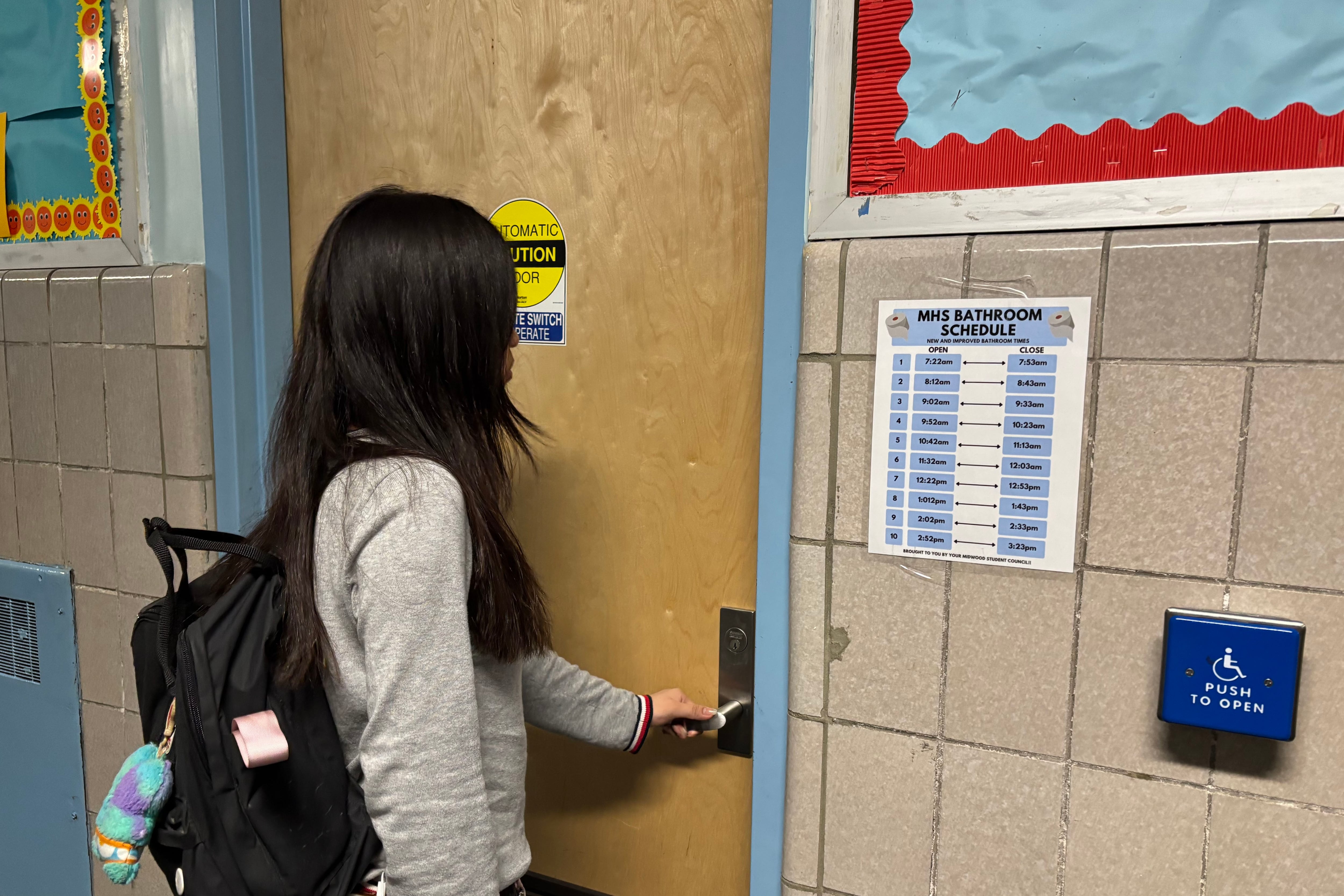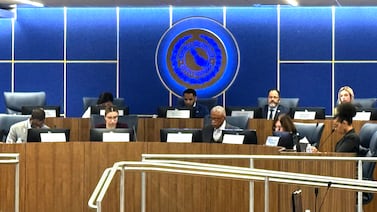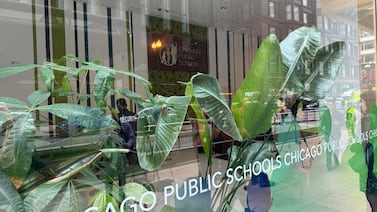Sign up for Chalkbeat New York’s free daily newsletter to get essential news about NYC’s public schools delivered to your inbox.
Cutting class. Fights. Vaping. School bathrooms have long been notorious for all sorts of illicit behavior. And in response, many schools now significantly restrict access to bathrooms or are adding surveillance tools, including vape detectors.
Producers Isabella Mason, of Midwood High School, and Bernie Carmona, from Beacon High School, wade into the debate over school bathroom policies.
At Midwood, for instance, the school locks bathroom doors for the five minutes while changing classes, and bars access during the first and last 10 minutes of class. The school’s assistant principal of safety and security, Richard Franzese, discusses the evolution of the policy and the lengths the school has gone to crack down on incidents. Beyond limiting the times the bathrooms are open, the school has bathroom sign-in sheets, allowing up to three students in at a time, and has school aides stationed outside.
“There’s no perfect solution,” he said.
And Chalkbeat reporter Michael Elsen-Rooney sheds light on how schools are specifically responding to student vaping, illuminating the tension between simply enforcing rules versus dealing with larger issues related to addiction and mental health.
P.S. Weekly is available on major podcast platforms, including Apple Podcasts and Spotify. Reach us at PSWeekly@chalkbeat.org.
P.S. Weekly is a collaboration between Chalkbeat and The Bell, made possible by generous support from The Pinkerton Foundation.
Listen for new P.S. Weekly episodes Thursdays this spring.
Read the transcript below
Joseph: I’ll have classes like, on the way end of the fourth floor, and I’ll have to go down to the annex of the basement, which are at the complete other ends of the school on the bottom floors. And it ends up being like a seven, eight minute round trip.
Isabella: You’re listening to a student who goes to my school, Midwood High School. His name is Joseph Trontz, and every so often he has to take a journey. And actually, he’s not the only one making the trek.
Joseph: This isn’t just a problem with me, either. This is, you know, a problem that a lot of students and, in fact, teachers have
Isabella: I have to take the same journey we all do. I’m Isabella Mason, and
Bernie: And I’m Bernie Carmona, and this is PS weekly, the sound of the New York City school system.
Isabella: So okay, let’s say it’s a typical day at Midwood High School and I’m at AP macroeconomics, and suddenly I get that urge to use the bathroom.
Bernie: Okay, nerd, so what’s your journey like?
Isabella: Okay? Step One, I have to decide what class is the best class to go based on how close it is, what the nearest bathroom is, and also who’s teaching it, because some teachers are more of a stickler for rules. Step Two, You’d think that I’d be able to go in between my class periods, but I can’t, because of a rule that my school has called the 10, 5, 10, rule, which basically says we cannot go to the bathroom the last 10 minutes of a class period, the five minutes that we have to transition between classes, and then the first 10 minutes of that class, which whatever. Step Three, If I’m in like macroeconomics, that’s definitely the worst class to go to the bathroom in, because of how far it is from the nearest bathroom. I either have to go downstairs to a bathroom that’s guaranteed to be dirty and like infested with vape smoke, or it goes two floors up and definitely have to wait in a line. Okay, Step Four, So for some classes, I need a sign out sheet whenever we leave the class, and then when I arrive at the bathroom, there’s a sign in sheet, which is just also whatever. And Step Five, I’m finished and back in class, but by then, I’ve missed around 10 or 15 minutes of class time,
Bernie: So you’ve signed in and out. How many times now?
Isabella: 3
Bernie: 3
Isabella: 3
Bernie: And what happens to these signatures? Like–
Isabella: I don’t, they don’t. I don’t even know why they have them, because I just scribble whenever I sign into the bathroom, they don’t check it. I don’t, I don’t know.
Bernie: And why do you have to travel so far?
Isabella: Because Bernie, unlike your school, we only have five bathrooms for 4000 students. Did you know we actually have four extra bathrooms that are just out of service? Okay, I was making sure we actually have nine bathrooms, but we don’t whatever. So the thing is, it isn’t just an issue at my school,
Bernie: Yeah, at my school, Beacon High School, we used to just walk out of the bathroom whenever we wanted to. I never had to raise my hand. But now we have the 10, 5, 10, rule, and for a lot of us, that kind of feels a lot more like surveillance and safety.
Isabella: So I wanted to figure out why these bizarre policies were in place. So who else to speak to besides the assistant principal of safety and security. Richard Franzese.
Franzese: I came here as a young teacher in 1995, I quickly became a dean shortly after that. And then in about 2002 I assumed the role of the assistant principal safety and security here.
Isabella: And how would you describe the atmosphere of Midwood? And I guess, yeah, the atmosphere of Midwood and also its shared spaces like hallways or bathrooms,
Franzese: Crowded, you know, crowded, sometimes the hallways. I always say it’s kind of like Grand Central Station on Christmas Eve, Everybody’s rushing to get home.
Isabella: Okay, do you think there is an excessive number of students in the bathroom at once?
Franzese: Yes, that can happen. What we do identify, and this is the truth. You have some students who legitimately need to use the bathroom, and there are other students that legitimately do not want to be in class, and every period, they will ask their teachers for the pass to use the restroom facilities bathrooms.
Isabella: And have you noticed the change in the school’s bathroom policies over the years?
Franzese: No question, and I’m probably the reason why that change took place so years ago, the bathrooms are not supervised by staff members such as school aids, but we did not have an effective pass policy or bathroom policy. That all started to change about 10 years ago, when I was able to introduce new policies, and primarily the reason being is that we wanted to cut down on the number of disciplinary incidents that occurred in these student bathrooms.
Isabella: How would you describe students’ reactions to the changes?
Franzese: I think it’s been mixed. I think in some cases, the students appreciate the fact that there’s only a limited amount of students that are allowed in the bathrooms. However, I think that students don’t like the ideas the bathrooms being closed throughout the day before the bell rings, the five minutes during passing and not immediately opened after late bill.
Isabella: All right, and how do you think these bathroom policies have helped reduce bathroom related issues like skipping–
Franzese: Without question. If I look at the data of incidents in the bathrooms, let’s say, from 10 years ago to today, this is sound very corny, but that the incidents have gone down like a duck in winter, that we’ve had less and less physical altercations, less incidents of fighting or any type of violation. The chances regulations students use the bathrooms and they leave for the most part, and if too many students congregate, that’s when a school aide, with the assistance of the deans, will come in and then clear out the bathroom.
Isabella: And can you describe what Midwood bathrooms used to look like or feel like, before these policies?
Franzese: They were very, very crowded. You had incidents of smoking, of play fighting, incidents of students, even I hate to say it, sometimes getting robbed in the bathroom too, and that was, obviously there are no video surveillance cameras in the bathroom. But, by enforcing this type of bathroom policy and with, with adult supervision outside of it. What we’ve noticed over the years, that these incidents have gone down, and it’s created a more safer environment.
Isabella: When policies were first implemented, were they always like the 10, 5, 10 rule? Or has it been like we have something here, but now it’s 10, 5, 10 rule? Maybe it’s a five, five, five rule–
Franzese: No, we’ve always done a 10, 5, 10 rule, but that’s actually now been changed. I think that we’ve, we’ve cut it down to seven minutes. I believe now, one of the things that student government had complained about that, you know, they would like to have the bathrooms open a little bit more. So we listened, we listened, and we said, Okay, how does 7, 5, 7, sound? They said we could work with that. So a compromise was made.
Isabella: So its bathrooms are closed for the first and last seven minutes of the period,
Franzese: Correct? And then the five minutes during, during the passing could not be compromised, because we did not want students hanging out the bathroom during passing as cutting class, so looking to skip class.
Isabella: And when it came to hiring and having to find the resources for bathroom aids, was that a challenge for Midwood
Franzese: Yes, it was initially our budget operated on fumes, meaning that we had very little financial sort of latitude. But since about 2016 when the school started receiving Title One funds, we were able to expand hiring school aid.
Isabella: And how do you feel about these policies? How do you think they impact students with medical needs or other special conditions?
Franzese: So if any students with medical needs, they know, and we explain to these students that they could utilize even the staff bathrooms. I myself have opened up the doors to the staff bathrooms for students, have a medical emergency. Or, for example, I one time had a student with colitis. What colitis is, it’s, it’s almost like an irritable bowel syndrome, that all of a sudden you have to go to the bathroom and it’s uncontrollable. We allow this student to use the staff bathroom at any moment’s time. We always make exceptions for students.
Isabella: And do you think Midwood’s bathroom policies need any more work? Or we’re fine with the 7,5,7–
Franzese: I think, listen, I know it works fine, as long as if students can think of something that would improve upon it, I will always listen. Doesn’t mean it’s gonna happen, but I will always listen.
Isabella: And do you think Midwood’s bathroom need any more work in terms of reducing like student drug use and vandalism or student skipping?
Franzese: There’s no perfect solution to that. I like, just recently what we did downstairs that we set up in the boys bathroom downstairs, we set up stanchions, and now the school aids only let two to three male students into the bathroom at a time, and that will cut down on the number of students, let’s say, cutting or hanging out, or any type of horse play, or possibly vaping. Could I put vape detectors in the rooms? I could do that, but it could also be, you know, a little bit of a big brother was watching. And I don’t want our students to feel that way, that could put vape detectors in so, but we don’t really have, you know, to be honest with you, do students vape? I’m sure they do. I know, but if we see it on camera, we confiscate the vapes. We follow the proper protocol in terms of the chances, regulations, and, you know, provide family out, parental outreach and explain, but we don’t really get a lot of incidents of vaping in the bathroom. Be quite honest with you,
Isabella: That’s what I was glad to hear because there’s been other schools that have implemented, like, vape detectors,
Franzese: Yeah,
Isabella: But it’s good to hear from right?
Franzese: We don’t have it. It’s not as prevalent. Listen, I’m sure they do. I’m sure if I go into the boys bathroom, and also I smell strawberries, that doesn’t mean that a boy decided to put body spray on him. Get my drift? That being said, well, if you did it, then again, in this day and age, you never know, but we don’t. When I speak to the school aides, and they go in to monitor and they will physically walk in, they don’t smell it, they don’t see it.
Isabella: And I guess if someone said it’s just a bathroom, why does it matter? How would you respond?
Franzese: It’s still Midwood High School. It’s no different than a classroom. It’s no different than a hall. It’s no different than the cafeteria. It’s no different than the gymnasium. You know, would it be your bathroom? Would it matter if it was your personal bathroom in your home? Yes, well the answer would…yes, it does matter.
Isabella: That was Midwood AP of security and safety, Richard Franzese. There was one part of our conversation. I wanted to learn more about vaping, even though Mr. Franchisee said it’s not a big problem at my school, I’ve seen kids vaping in the bathroom more times than I can count, and I know my school is not alone on this issue.
Bernie: I also think your school isn’t on its own. Overall, teen vaping rates have declined from five years ago, and that was during a time when almost 1/3 of all teens were vaping. Cannabis, however, is on the rise recently, and vaping has been a problem for over a decade,
Isabella: Right? 10 years the same time period when my school’s bathroom policies started getting stricter.
Bernie: So next up, we’re digging into teen vaping, why it’s happening, and what some schools are trying to do about it. But first the break
Zimmer: We hope you enjoy listening to PS weekly as much as we enjoy making it. I’m Amy Zimmer with Chalkbeat New York. We spend a lot of time planning each episode, setting up and conducting interviews, cutting the tape, writing scripts. It’s a long process and totally worth it. But here’s the thing, we don’t have a bunch of money or millions of followers, so we’re counting on you loyal listener to help us get the word out. Take a few seconds and send this link wherever you’re listening to three friends so they too can enjoy PS weekly. Thanks for your support.
Bernie: Welcome back to PS Weekly. I’m Bernie,
Isabella: And I’m Isabella.
Bernie: At the end of Isabella’s interview with her assistant principal, they were talking about an issue that has been on both of our minds, and that issue is vaping. I’ve seen it happening more and more at my school, and I was especially curious to learn more of the vape detectors that Mr. Franchisee mentioned, even though Midwood hasn’t installed them, other New York City schools have. So we called up a Chalkbeat reporter, Mike Elsen-Rooney, who has been writing about these issues, to find out more.
Rooney: Yeah, so I’d been writing about issues related to teen drug use and vaping for a couple years, and I got interested in it because a couple years ago, I started hearing from more people who work in schools that they were just seeing more visible drug use, like spilling into the school day, and that was around the time when we were seeing a lot of the kind of smoke shops popping up around the city. It was still, like, pretty fresh off the pandemic. And so I think a lot of kids were, like, struggling with mental health. You know, at some point after I wrote that first story, I started kind of reaching out to people about, like, do you have policies in place? What are you doing to try to address this? And I heard about just a number of kind of interesting different approaches, ranging from counseling to, like, actual policies of like, you know, locking or restricting bathroom use to installing vape detectors, which I had never heard of until I started doing this reporting. Can
Bernie: Can you tell me a little bit more about those policies that you were finding and what helped you, like, add those to the article of from Chalkbeat.
Elsen-Rooney: Yeah. So it’s hard to quantify, because the DOE is not keeping track, really, of any of this centrally, and the DOE is not buying vape detectors centrally either. It’s just kind of been like a little scatter shot among schools who are interested. But I definitely found a couple examples. I reached out to one company that said they were working with about 30 schools in New York City, and that was just one company. And then bathroom policies, how prevalent those are is also really hard to know, but certainly anecdotally, like talking to teenagers, to some of you guys last year, like it’s not an uncommon thing to have.
Bernie: And how do you think vaping compares with the drug use in the bathroom? Because I know that were some of these vaping devices also meant to, like, alert admin about the drug use or?
Elsen-Rooney: Right? So, yeah, this is, I, you know, when I was in high school, vaping was not really a thing, right? And it’s like, exploded since then, and so I’ve had to kind of learn about some of this. But basically, like, as people may or may not know you can vape either nicotine or THC, it’s a little hard to tell sometimes which one is which you know. Sometimes the devices look different, but like they don’t really emit, always a super clear smell. And one of the selling points, of some of these vape detector devices. I’m not sure how well it actually works, but was that it could distinguish between THC vapor and nicotine vapor. So I think, as you pointed out, that THC is probably a more kind of immediate concern for schools, because then you have kids in school who are like under the influence, and it’s also really like what I heard from substance abuse people is that their biggest concern is that if you are doing that in school, that is an indication that you are addicted.
Bernie: Are there any positive changes that have you know arose in regarding vaping since the introduction of these devices. Or how do you think it’s helped? You know, just in general, track student drug use?
Elsen-Rooney: Yeah, so from one principal I talked to, like they did really see a pretty significant reduction in kids vaping in the bathroom. AndI talked to students who were so kind of frustrated that people would be vaping in the bathroom and they did not want to be around that, that they just wouldn’t go to the bathroom all day, which is a problem. But then if you have policies that maybe restrict the amount of time people can be in the bathroom, then they also are not using the bathroom. So it’s like there’s trade-offs, certainly this principle felt like the vape detectors were kind of an effective way to at least make this problem more visible and allow the school to kind of address it, because it’s hard for administrators to know what’s going on in the bathrooms.
Bernie: Yeah, it is. I’ve heard there’s, like, substance abuse counselors in these schools. How do you perceive the role of those substance abuse counselors in schools?
Elsen-Rooney: Yeah, that was one of the biggest surprises for me in doing this reporting, that we basically have half the number of substance abuse counselors that we had, like, a couple decades ago. And you know, arguably, like the mental health challenges, the kind of availability of some of these products has, has grown even more kind of pervasive. And so the fact that we have like, 260 or so SAPIS counselors in a school in a system with 1600 schools, which is like an eighth or seventh of schools. You know that, to me, kind of speaks to the fact that we as a system are still not adequately confronting the magnitude of this challenge and what it would actually take to address it in a real way.
Bernie: Looking ahead, what changes would you like to see in the school’s handle of vaping and bathroom policies?
Elsen-Rooney: Yeah, I don’t, I don’t think there’s, like an easy, clear cut solution here, but what I would like to see is just more discussion of this at, like, a city wide level, like, like I said, I think if you just completely leave it to schools to deal with on their own, like, number one, it’s not it’s a lot of burden to put on schools. And number two, you might start to see these kind of inequities in how schools respond. And so I think, like a more robust system wide, city wide, discussion of like this is an issue would be a good first step.
Bernie: That was Mike Elsen-Rooney, a reporter from Chalkbeat,
Isabella: Schools are creating massive restrictions to stamp out the limited number of vape or behavior incidents that only sometimes happens,
Bernie: Everyone is being harmed throughout this process, and it’s taking a sledgehammer to an issue that maybe could be solved with something much smaller.
Isabella: So what do you think schools should do differently?
Bernie: Well, the DOE and schools should be consulting with students and making any bathroom policies. Students should have their voices represented in these policies. And for Midwood, maybe they should just open up more bathrooms.
Isabella: Yeah, duh.
Isabella: PS weekly is a collaboration between the bell and Chalkbeat made possible by generous support from the Pinkerton Foundation, the Summerfield foundation and FJC
Bernie: Producers for this episode were me, Bernie Carmona
Isabella: and me Isabella Mason, and with reporting help from Chalkbeat reporter Michael Elsen-Rooney,
Bernie: Our executive producer for the show is Ave Carrillo and executive editors are Amy Zimmer and Taylor McGraw.
Isabella: Additional production and reporting support was provided by Mira Gordon, Sabrina DuQuesnay and our friends over at Chalkbeat. Our engagement editor is Carolina Hidalgo.
Bernie: This episode was made using Hindenburg Pro music is from Blue Dot sessions, and the jingle you heard at the beginning of this episode was created by the one and only Erica Wong and
Isabella: And a big special thanks to. Our mentor, Harry Higgins, who was super duper awesome and helped us with this story.
We make transcripts available for our episodes as soon as possible. They are not fully edited for grammar or spelling.






